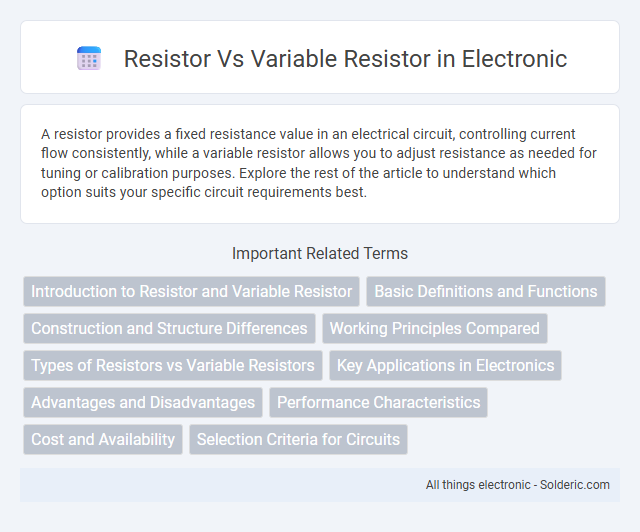A resistor provides a fixed resistance value in an electrical circuit, controlling current flow consistently, while a variable resistor allows you to adjust resistance as needed for tuning or calibration purposes. Explore the rest of the article to understand which option suits your specific circuit requirements best.
Comparison Table
| Feature | Resistor | Variable Resistor |
|---|---|---|
| Definition | Fixed resistance component | Adjustable resistance component |
| Resistance Value | Constant, predefined | Changeable within a range |
| Common Types | Carbon film, metal film, wirewound | Potentiometer, rheostat, trimmer |
| Usage | Stable current limiting, voltage division | Calibration, tuning, volume control |
| Adjustment | No adjustment possible | Manual or electronic adjustment |
| Cost | Low | Higher than fixed resistors |
| Applications | General circuits, fixed biasing | Variable signal control, calibration circuits |
Introduction to Resistor and Variable Resistor
Resistors limit electrical current by providing a fixed resistance, ensuring consistent voltage and protecting circuit components. Variable resistors, such as potentiometers, allow you to adjust resistance manually, enabling control over current flow and signal levels in your devices. Understanding the difference between these components is crucial for designing and troubleshooting electronic circuits effectively.
Basic Definitions and Functions
A resistor is a fixed electrical component that limits current flow and drops voltage within a circuit by providing a specific resistance value measured in ohms. A variable resistor, also known as a potentiometer or rheostat, allows adjustment of resistance manually, enabling control over current and voltage in real-time applications. Basic functions of resistors include current regulation and voltage division, while variable resistors provide adaptable resistance for tuning circuits, calibrating devices, and adjusting signal levels.
Construction and Structure Differences
A resistor typically consists of a fixed resistive element made from materials such as carbon film, metal oxide, or wire-wound, encased in a protective housing with two terminals. In contrast, a variable resistor (potentiometer or rheostat) includes an adjustable wiper that moves along a resistive track, allowing for the resistance value to be manually varied. The internal structure of a variable resistor features a sliding or rotating contact, providing a dynamic resistance output unlike the static configuration of fixed resistors.
Working Principles Compared
Resistors provide a fixed resistance value, controlling current flow by converting electrical energy into heat based on Ohm's law. Variable resistors, or potentiometers, adjust resistance dynamically through a movable contact sliding over a resistive element, enabling fine-tuning of voltage or current in a circuit. Your choice between the two depends on the need for either stable resistance or adjustable control in electronic applications.
Types of Resistors vs Variable Resistors
Fixed resistors come in several types, including carbon film, metal oxide, wire-wound, and surface-mount, each suited for specific applications based on tolerance, power rating, and stability. Variable resistors, commonly known as potentiometers or rheostats, allow continuous adjustment of resistance within a specified range, making them ideal for tuning and calibration tasks. Your choice depends on whether precise fixed resistance or adjustable control over current flow is required in the circuit design.
Key Applications in Electronics
Resistors are essential for controlling current flow and voltage levels in fixed applications like voltage dividers, biasing circuits, and signal conditioning. Variable resistors, such as potentiometers and rheostats, allow dynamic adjustment of resistance, making them ideal for tuning, calibration, and user input controls in devices like audio equipment and sensors. Understanding your circuit requirements helps determine whether a stable or adjustable resistance element best suits the intended electronic function.
Advantages and Disadvantages
Resistors offer stable, fixed resistance values ideal for maintaining consistent current flow in circuits but lack flexibility for varying conditions. Variable resistors provide adjustable resistance, allowing fine-tuning of voltage and current, which benefits applications like volume control or sensor calibration, but they can be less reliable and more prone to wear over time. Your choice depends on whether you need precision and permanence or adaptability and control within your electronic design.
Performance Characteristics
Resistors provide a fixed resistance, ensuring stable and predictable electrical performance in circuits by limiting current flow and dividing voltage with minimal variation over time. Variable resistors, such as potentiometers and rheostats, enable adjustable resistance, allowing precise control of current and voltage in real-time applications but may introduce noise or wear due to mechanical movement. The performance characteristics of variable resistors depend on their linearity, power rating, and tolerance, impacting their suitability for dynamic signal adjustment versus the consistent performance of fixed resistors.
Cost and Availability
Resistors are generally more cost-effective and widely available due to their simple fixed resistance design, making them ideal for standard electronic applications. Variable resistors, such as potentiometers and rheostats, tend to be pricier and less commonly stocked because of their adjustable functionality and more complex construction. Your choice between the two should consider budget constraints and the need for precise resistance adjustment in your circuit design.
Selection Criteria for Circuits
Resistor selection for circuits depends on fixed resistance values to provide consistent current control, power rating, tolerance, and operating temperature range, ensuring stable performance in defined conditions. Variable resistors, or potentiometers, are chosen when adjustable resistance is needed for tuning, calibration, or user-controlled voltage division, emphasizing linearity and mechanical durability. Design requirements such as precision, power dissipation, and adjustability dictate the appropriate choice between fixed and variable resistors to optimize circuit functionality.
resistor vs variable resistor Infographic

 solderic.com
solderic.com